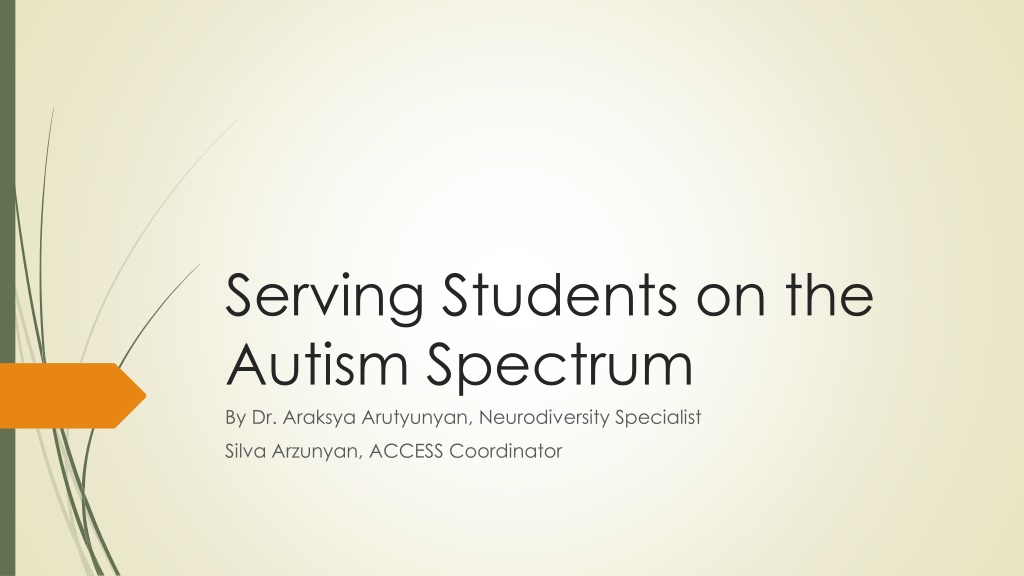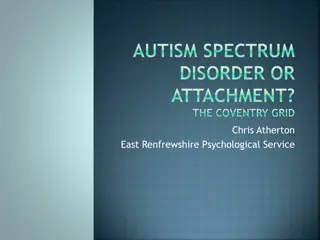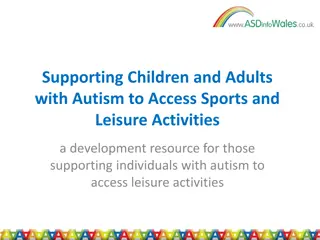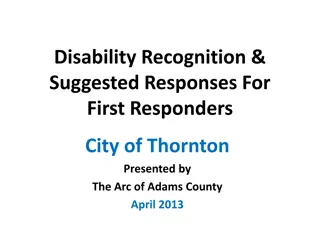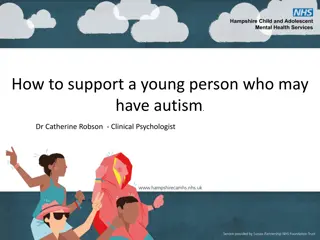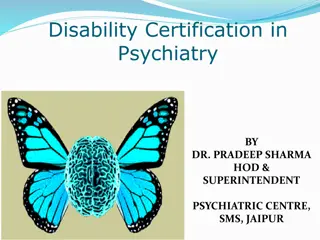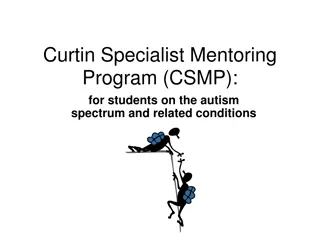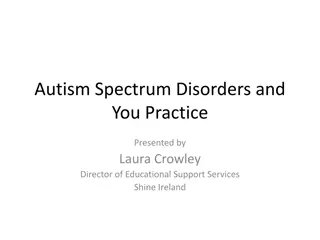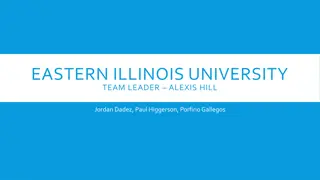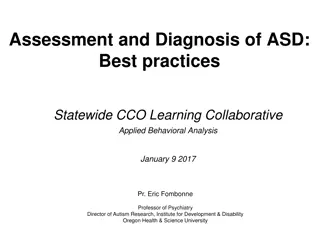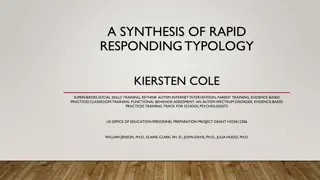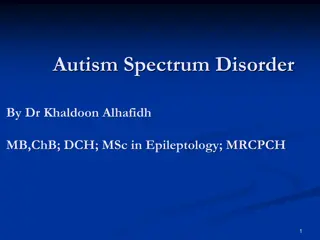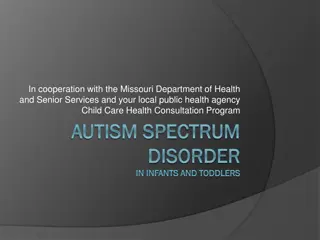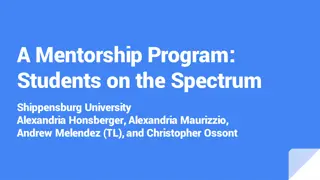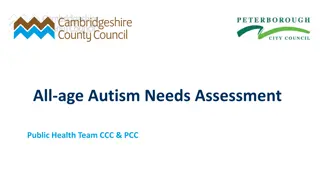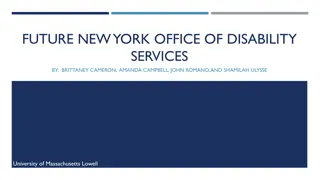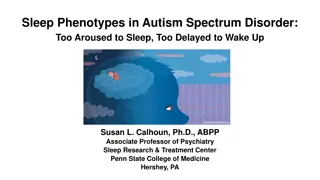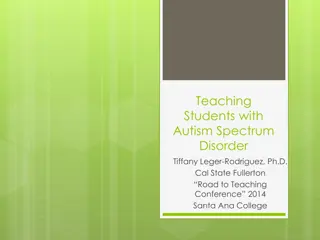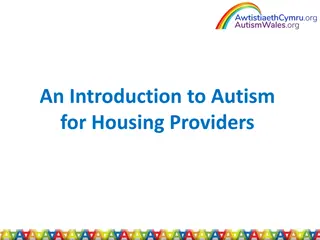Understanding Autism Spectrum Disorder and Supporting Students
Autism Spectrum Disorder (ASD) is a neurodevelopmental disorder with persistent impairments in social communication and restricted, repetitive behaviors. This presentation covers diagnostic criteria, classroom behaviors, response strategies, academic accommodations, national statistics, causes of increase, and more. Learn how to better support students on the autism spectrum for improved educational outcomes.
- Autism Spectrum Disorder
- Supportive Strategies
- Education
- Neurodevelopmental Disorder
- Academic Accommodations
Download Presentation

Please find below an Image/Link to download the presentation.
The content on the website is provided AS IS for your information and personal use only. It may not be sold, licensed, or shared on other websites without obtaining consent from the author. Download presentation by click this link. If you encounter any issues during the download, it is possible that the publisher has removed the file from their server.
E N D
Presentation Transcript
Serving Students on the Autism Spectrum By Dr. Araksya Arutyunyan, Neurodiversity Specialist Silva Arzunyan, ACCESS Coordinator
What will be covered What is Autism Spectrum Disorder Some Diagnostic Criteria Classroom behaviors that may arise How to respond to classroom behaviors Academic accommodations that may be helpful Questions and troubleshooting
What is Autism Spectrum Disorder? ASD is a neurodevelopmental disorder spread across a spectrum (ranging from mild to severe). The essential features are persistent impairment in social communication and interaction; and restricted, repetitive patterns of behavior, interests, or activities. Present from early childhood and limit or impair daily functioning. (APA, DSM-5, 2013)
National statistics 1 in 59 births in the U.S. has autism (CDC, 2018) Used to be 1 in 150 in 2000 and 1 in 68 in 2012 (CDC, 2014) 119.5% increase from 2000 6-15 percent increase each year from 2002 to 2010 (based on biennial numbers from CDC). Each year and estimated 50,000 teens age out of school based services (CDC, 2018). This means we have more students with autism entering our classrooms. 35% of young adults (ages 19-23) with autism have not had a job or entered higher education after high school (Shattuck et al., 2012)
Whats causing the increase? Environmental factors. Diagnostic criteria/changes in DSM 5 Sampling differences. Some areas gave researchers more access to complete student records. Perceived advantages and support out there? Increased awareness in minority groups.
Some diagnostic criteria.. Deficits in social communication and Social interaction such as Social-emotional reciprocity (ranging from inappropriate social approach; to lack of sharing of interests, emotions, or affect; to failure to initiate or respond to social interactions). Deficits in nonverbal communication (poor eye contact and atypical body language, deficits in understanding and use of gestures, lack of facial expressions). Deficits in developing friends/relationships, maintaining them, and/or understanding them (difficulties in adjusting behaviors to fit various social contexts to lack of interest in peers). (APA, 2013)
Some diagnostic criteria.. Restricted, repetitive patterns of behaviors, interests, or activities: Repetitive motor movements, speech (i.e. simple motor stereotypies, echolalia, idiosyncratic phrases). Difficulty adjusting to changes in routines or in the environment. Difficulties with transitions (i.e. need to take same route or eat same food every day, greeting rituals). Highly fixated and intense interests (i.e. knows everything there is to know about Disneyland). Hyper- or hyporeactivity to sensory input and the environment (i.e. lights, noise, the feeling of the seat).
Classroom behaviors that may arise Easily distractible Concrete black and white thinking Rule bound Show little or no interest in friends/relationships OR have interest, but can t Problems generalizing across settings Deficits in executive functioning skills Poor judgment and decision making Rigid thinking inflexible
Some of the challenges: Executive Functioning Deficits What are EF: Umbrella term used to look at different cognitive processes. Planning Working memory Attention Inhibition Self-regulation initiation
What research says about teaching students these skills. Strategy instruction should be embedded in the curriculum, as it will benefit ALL Students and is essential for the academic progress of students with learning and attention challenges (Goldstein, & Naglieri, 2014; Deshler, Ellis, & Lenz, 1996; Ellis, 1993, 1994). Skills to focus on in order to teach EF: cognitive flexibility/shifting, emotional and self-regulation, impulse control, organizing and prioritizing, self-monitoring and self-checking.
Flexibility The ability to shift back and forth between different approaches to a problem and make changes to your plans as needed. How can we teach flexibility in the classroom? Embed strategies for teaching ways to thinking about different possible outcomes to a problem. Emphasize problem solving and critical thinking. To teach students to view situations from the perspective of their peers, encourage peer discussions and collaborative learning. Incorporate jokes, riddles, and puzzles into activities to help practice flexibility with different meanings of words, different interpretations, and manipulations.
How can we teach flexibility in the classroom? Cont. Focusing on reading comprehension can help students practice shifting between and among major concepts and details. Students also need to study differently for different types of tests. Provide tips on how to study for each type: Multiple choice tests- study more specific details. Essay format- know more major concepts and be able to tell a story.
Emotional and Self Regulation The ability to regulate both the emotions and the self avoiding extreme mood changes. Some proactive approaches to help: understand students have different learning styles, experience difficulties in different areas, and have different emotional vulnerabilities. Try to know and anticipate the triggers that activate a strong emotional reaction. Develop an individualized prevention and intervention plan for vulnerable students that can be incorporated in the classroom.
Emotional and Self Regulation help cont. Prevention Approaches may include helping or suggesting the student breaks down tasks into smaller and more manageable ones and/or giving alternative assignments that the student may be able to feel more successful completing. Intervention Approaches may include providing support and avoiding judgement, anger, or blame. Offering a student a place to reduce stress or a less distractible room to take tests may be some ways to help a student regulate frustrations.
Impulse Control The ability to inhibit your impulses, such as waiting to speak until called upon. Explicitly teach classroom expectations of respect for others by using positive interventions and supports (PBIS). Identify three to five positively stated behaviors or expectations (i.e. raise your hand, wait to be called on, etc.) Teach the expected behaviors explicitly and systematically. Develop a system for recognizing when desired behaviors occurred, and Plan an appropriate response (in advance) when undesired behaviors occur.
Organizing and Prioritizing The ability to schedule activities and keep track of time and materials so that work is finished on time. Reading comprehension has been called one of the major cornerstones of teaching organization and prioritization. Using thinking maps and graphic organizers provide students with a structured format to help them extract major themes and understand meanings. Making columns and separating main ideas from supporting ideas can be used to teach students note taking skills. Reading the textbook and writing down important information. Using structured methods to help students take notes will teach them skills needed later.
Self-monitoring and Self-checking Involves setting goals, reviewing their progress towards their goals, evaluating outcomes, and shifting back and forth as needed to make improvements. Self monitoring skills require metacognitive awareness and flexibility. Explicitly teaching students systematic, structured, and scaffolded strategies of self-monitoring can help students become more independent in using these skills. Encourage the use of calendars and planners to help with goal setting and breaking down tasks. Suggest mnemonics to help students learn to check their work and teach steps to check their math calculations. Checklists can be helpful to check their work before they turn it in.
Academic Challenges and Some Tips to Help Writing Papers Frequent challenges Producing a narrative vs. lists of facts or outlines Essay questions (understanding the question, flow of ideas, writing enough) Term papers/long-term assignments (planning, time management, staying on topic) Compare and contrast Using perspectives
Academic Challenges and Some Tips to Help Suggested help Make use of the writing center or tutors that can work on writing Faculty can also use the following suggestions. Help the student maintain focus and not write tangentially Attach sticky notes on pages as reminders for the student Review the paper with the student in comparison with the instructor s requirements Write down notes for the student or make a list of tips which can help them on future papers. Instead of writing suggest trying dictation software, outlining first (to help with expanding the paper), audio recording with or without transcription.
Academic Challenges and Some Tips to Help Taking exams Frequent challenges Essay questions Following the directions Processing speed Distractions Sensory issues
Academic Challenges and Some Tips to Help Suggested help Make sure the student receives accommodations from ACCESS. Use concrete steps and suggest a script for the student to request the support. Use concise directions, bullet point format Extra time Distraction reduced setting Fidget toy
Academic Challenges and Some Tips to Help Presentations and group projects Frequent challenges Social anxiety Language problems Speed Narrow or literal interest in topic Tone of voice (of the student AND of the teacher)
Academic Challenges and Some Tips to Help Suggested help Present to a smaller group, present only to instructor, pre-record your presentation Discreetly facilitate including the student in a group or pairing them with someone Introductions to help warm them up to others in the class Help with time management (timers, five minute prompts) Allow to pick their topic of interest if there is flexibility Recognize that your tone isn t always interpreted the way you d like it to be Suggest prior practice with peers or instructor
Academic Challenges and Some Tips to Help Taking notes Frequent challenges Struggles to take down information verbatim Large gaps in the notes Irrelevant information in the notes Extrinsic barriers (harsh lighting, seating arrangements, open door, uncomfortable temperatures)
Academic Challenges and Some Tips to Help Suggested help Notetaker, recorder, smart-pen Provide slides if possible Provide an outline with space to write notes in Allow for headphones, sunglasses as a way to reduce sensory stimulation Adjust lighting if possible, close windows/doors to reduce noise Accommodate for seating arrangements Suggest to dress in layers, jacket
Contact us with questions and/or concerns Araksya Arutyunyan AArutyunyan@vcccd.edu Silva Arzunyan SArzunyan@vcccd.edu
